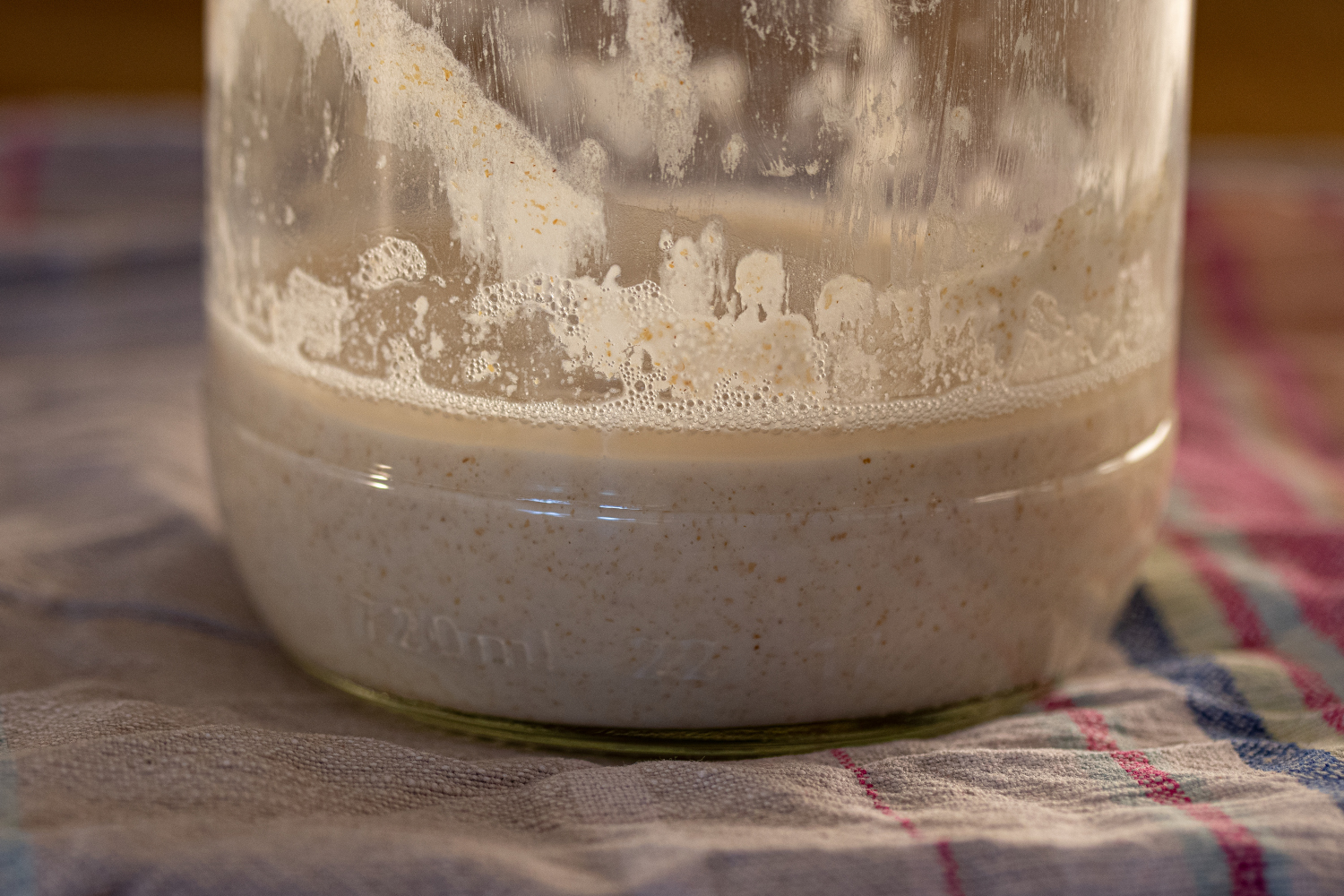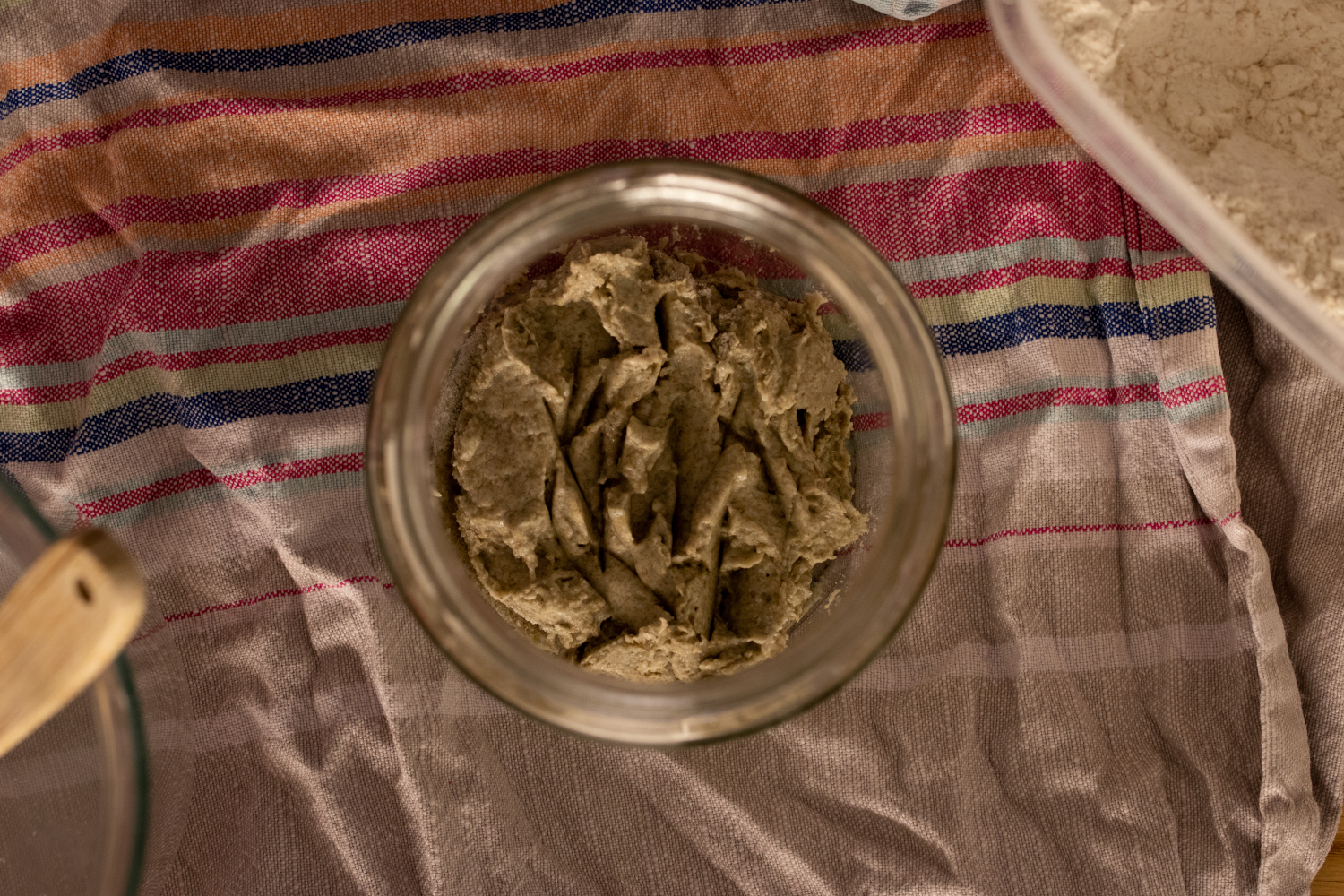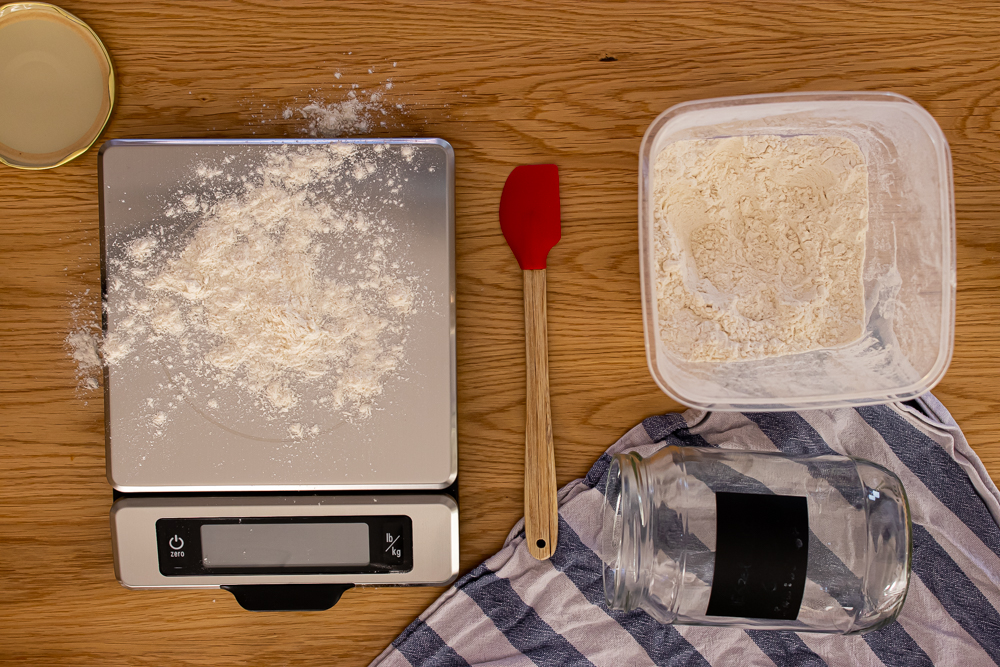This post is a collection of questions that I had during my sourdough journey and the answers that I found and what I have learned during this process. You could take this as my personal research notebook regarding sourdough starter.
Why should I bother making and using a sourdough?
By the time I am writing this post we are in the middle of the COVID-19 pandemic and supplies in the stores are running thin. In my past several trips to the store, I could not find any yeast at all. So, in that case, you can make your own wild yeast.
Besides the necessities, a sourdough starter will give extra depth and a bit of tanginess in the flavour of your baked creations. Especially for bread making, it will give a crunchier crust to your bread and a more airy crumb.
Finally, the process of making it is quite simple, requires only flour, water and a bit of time, but it is interesting and fun. You get to see how the sourdough starter grows and evolves over time. It feels like having a pet that you should feed and take care of and it won’t disappoint you.
“Feeding” the starter
The sourdough starter is a “living” thing and needs to be fed in order to survive. Feeding the starter means refreshing it usually by discarding part of it and replacing it with flour and water. If you need a bigger amount of it for baking or you want to give part of your starter to some of your friends you don’t have to discard your old starter. You can proportionally increase the amount of water and flour as needed.
Sourdough Starter vs Levain
In general, the word starter refers to a mix of flour and water that you feed and mature over time. It can also be referred to as the mother starter. The word Levain can be used for any leavening agent such as yeast, baking powder and baking soda. In the context of sourdough, levain is the mix that will be made right before baking and will be used as part of the recipe. It consists of part of the mature starter that is fed according to the recipe needs.
What kind of containers should I use?
Any food-safe container with a lid will work fine. It needs to be big enough to contain at least 3 times the amount of starter you use so it won’t overflow during the rise and fall cycle. The lid should be able to sit on the container without sealing it tightly. As the starter ferments, it produces carbon dioxide and closing the container tightly might create a small bomb.
I prefer round containers because they are a bit easier to clean and wipe down the starter from the container walls compared to square ones. I also prefer glass containers for the same reason. I use a glass jar with a screw-on lid for my mature starter and a plastic container for the levain.
Finally, I like to move my starter in a clean container once in a while, especially when there is a lot of dried out starter on the walls of the container.
Should I use tap water to feed the starter?
Generally filtered and purified water should be used to feed the starter. Tap water should be fine in most cases as well. I have only used tap water so far and I didn’t have any problems. However, if your tap water is highly chlorinated then you should not use it directly. It is better to put some in a container and let it stay at room temperature overnight, or 3-4 hour in the fridge. This will help to reduce the amount of chlorine in the water. Another solution is to use a filter for your tap.
What kind of flour should I use for my starter?
The rule of thumb regarding the flour is that it should be organic unbleached and not heavily processed flour. When creating a new starter it is better to use whole grain flours that are full of nutrients. Rye and wholewheat flour work best in the beginning since they help kick-start the fermentation process. For maintaining the starter, a mix with all-purpose flour works better. I use a mix of 50% Wholegrain (Rye or Wheat) and 50% All-purpose flour in order to feed my starters.
What is a good fermentation temperature
The hotter the temperature, the faster the starter (and any other dough) will ferment. A good temperature for your starter is about 20-22°C. To speed up the process, especially when you make a levain, you can go up to 30°C. For example, you can use the oven with only the light turned on. It creates a warm and draft-free environment that works really well. If you want to slow down the fermentation process instead, you can put your starter to the fridge so you don’t have to feed it every day. For more details about that check the question about preserving the starter.
How much should I feed my starter
Feed ratio is the amount of old starter compared to fresh flour and water you use in your feedings. It depends on the flour you use and how sour you want the starter and your future dough to be. The most common ratios that I found are
- 1 to 1: 1 part starter, ½ part flour, ½ part water
- 1 to 3: 1 part starter, 1 part flour, 1 part water
- 1 to 5: ⅕ part starter, ⅖ part flour, ⅖ part water
For more nutrient flours such as Rye, since it’s more active I use the 1 to 5 ratio so my starter doesn’t ferment too fast and become too sour. For wholewheat flour, I use the 1 to 3 ratio, which is the most common one. If you use only All-purpose flour the 1 to 1 ratio should work better since All-purpose flour in a starter ferments much slower.
If the starter has become too sour, you can use a lower feed ratio (eg 1 to 5) to reduce the sourness a bit.
How often should I feed my starter?
The most common feeding frequency is every 24 hours, especially if you are baking often. You can increase the feeding frequency up to every 8 hours if you are trying to revive your starter for example when you take it out of the fridge, or if you want to reduce the sourness a bit. You can also extend the feeding frequency to once every week if you store your starter in the fridge. More about this on the “How do I preserve my starter?” question.
 A bit of hooch on my wheat starter
A bit of hooch on my wheat starter
What is the clear liquid on top of my starter?
This liquid is called hooch and it is the alcoholic byproduct of the fermentation process. You can either mix hooch with the starter if you want to make your starter a bit more sour or discard it to make it less sour. In any case, it is an indication that your starter is a bit hungry and you might want to increase the feeding frequency or use a bit more flour in your feedings.
How can I adjust the sourness of my starter?
The name “sourdough” starter is a bit misleading as it doesn’t necessarily have to be sour. The sourness level can be adjusted in several ways. To make the starter sourer:
- Mix the hooch with your starter.
- Reduce feeding frequency. Let it ferment for a longer time.
- Increase the feed ratio. Use more of your old starter.
To make the starter less sour:
- Discard the hooch before mixing your starter.
- Feed the starter more often, so the fermentation period is shorter.
- Decrease the feed ratio. Use less of your old starter and let fresh flour and water take its place.
 Rye sourdough starter that needs just a bit more water
Rye sourdough starter that needs just a bit more water
What hydration percentage should I use for my starter?
The hydration percentage is calculated through the baker’s percentage process and it is the amount of water used compared to the amount of flour. For example, if you use equal amounts of flour and water then you have a starter of 100% hydration, which is the most common one.
While you are creating your starter, higher hydration (eg 125%) is preferred as it speeds up the fermentation process, especially if you are using Rye flour, which tends to absorb more water. On the other hand, when you have a mature starter, lower hydration works better (100%) since you want a bit slower and more controlled fermentation. Most recipes require 100% hydration starter so I suggest sticking with this ratio.
So far I have seen only a couple of recipes that require Rye starter of 166% hydration, but in this case, I keep a 100% hydration starter and make a 166% hydration levain for the recipe right before baking.
Why should I name my starter
This is completely optional, but it is fun to do. When naming something you are getting attached to it, especially when you start referring to it by its name. It creates a bond that will help you take care of it and not forget to feed it.
How does the starter affect the bread flavour
The starter affects mostly the sourness and the texture of the bread. Since the amount of starter compared to the amount of flour that you use for bread is quite small, the starter will not dictate the end flavour of your baking goods. It will rather act as a base where you can develop different flavours on top of it. So different types of flour will give you a different starting point for your bread.
Using whole grain flour in sourdough bread will give you a more complex flavour, because of the variety of minerals it contains, and a more dense and heavy crumb. All-purpose or white flour will give you a lighter and softer bread crumb, with more holes in it, and a simple flavour base for your bread.
When is my starter ready to use?
A good sign of a healthy sourdough starter is a consistent rise and fall cycle. Also, a mild and fruity aroma is another good indication that your starter is ready. There is also the trick where you put one teaspoon of your starter in cold water, and if it floats it should be ready. However, this trick might not work with a Rye starter, as the flour is more dense than the wheat one.
How do I preserve my starter?
The easiest way to preserve your starter is to feed it every day. However, this might be cumbersome and quite expensive, especially if you don’t bake often. The best way to slow down the fermentation is to put your starter in the fridge. This can be referred to as the retarding process, especially for bread dough.
When you keep your starter in the fridge you should feed it once every 4 to 7 days. To do that remove your starter from the fridge, feed it as you would normally, wait for 1-2 hours so it can start fermenting and then put it back in the fridge.
If you want to use your starter to bake, remove it from the fridge the night before, and feed it at least 2-3 times before using it, once every 8 hours.
Other options to preserve the starter is to freeze it or to dry it out. However, I haven’t tried any of those methods but I suggest to check Alex’s video on how to put your starter on hold, or The Perfect Loaf’s guide on storing your starter.
Where did you learn about sourdough? References
I mostly read for my recipes online, and try to find several sources for what I am looking for and then try them on my own and adjust things in the way as I see fit. Usually, I have a theory about a question and try to answer it by reading several posts and then experimenting with recipes until I find one that works for me. I keep a small notebook with most of the recipes that I try and notes to improve the next time. Also, most of the answers in this post come from my experience with the sourdough starter.
Having said that there are several sources that stand out.
- Alex the french guy cooking has a bread odyssey series and helped me at the beginning of my journey.
- Jacob Burton also helped me in the beginning, with his explanation of the baker’s percentage, and a simple sourdough starter and bread recipe.
- Joshua Weissman helped me with the more advanced techniques.
- The perfect loaf helped with the details around flours.
I hope you learned something new from this post, and that I have answered some of your questions. Let me know if have any more questions in the comment sections and I will try to answer them. If you are looking for how to make a sourdough starter check my Simple sourdough starter and Advanced sourdough starter posts.
Enjoy baking and keep on jamming.
